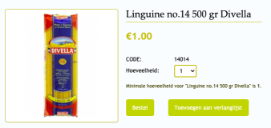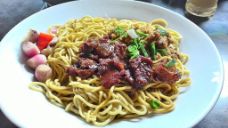A polyglot dish
One day, when I was helping my parents in our restaurant, I went to the storage and saw large packs of pasta. On these packs I clearly saw the Italian flag and the text 'prodotto in Italia’. My father told me that those Italian noodles were used to make bami goreng. I realised that the noodles used for bami are indeed similar to linguine, but never thought about it. This really sparked my interest and desire to delve into this peculiar dish, so let us take a closer look at this container full of bami.
The word'bami' is derived from the Hokkien word 'bakmi', pronounced as bah-mi 肉面. Hokkien, also known as Minnanhua, is a dialect of Chinese spoken in the Southern Chinese Fujian province. Bah-mi can literally be translated to ‘meat’, bak and ‘noodles’, mi. Chinese immigrants from Fujian brought the dish to Indonesia, and nowadays it has become a very popular dish in Southeast Asia. While the word bami is derived from Hokkien, the word goreng, which means ‘(stir-)fried’ is derived from Bahasa Indonesia. The word bami goreng already shows the diverse character of the dish: it is both a mix of a Chinese and a Malay language.
From Southeast Asia, the word entered the Dutch language, and even English. In the Oxford Dictionary of Food and Nutrition we see the term 'bami goreng' explained as: “noodles with fried shredded vegetables, served with diced pork, chicken or prawns, topped with strips of omelette.”[Cf] The Dutch dictionary, van Dale, describes bami as: “gerecht van mie met varkensvlees en groenten”, which can be translated to “dish of mie with pork and vegetables”.[Cf]
When looking into the noodles that are used for bami, we often see that wheat noodles are mentioned. The bami goreng we know from Chinese-Indonesian restaurants in the Netherlands usually consist of yellow pale noodles served with leek, meat and egg. Former restaurant-owner Mingfang Wang uploaded a recipe on YouTube to make bami at home, and she also mentions that linguine can be used to make this dish.[Cf] When searching for bami recipes on Dutch food blogs, we often see that they use something called 'mie nestjes' These 'mie nestjes' are made of wheat flour and the supermarkets sell these to make bami at home, but these ‘nestjes’ are not necessarily used to make bami in Chinese-Indonesian restaurants.
From all this we can see that the word bami in Dutch can describe a myriad of noodle dishes, using minced or diced pork, chicken, prawns, and numerous vegetables. Yet, when speaking of bami, most Dutch of the Chinese-Indonesian dish from the restaurants.


